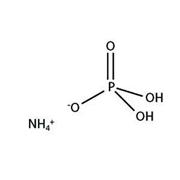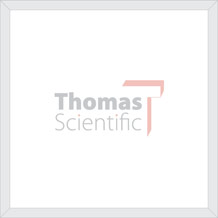500 g, bioWORLD
-
Ammonium phosphate, monobasic
bioWORLDIt is formed when a solution of phosphoric acid is added to ammonia until the solution is distinctly acidic. It is often used in the blending of dry agricultural fertilizers. It supplies soil with the elements nitrogen and phosphorus in a form which is usable by plants. The compound is also a…
-
Nutrient Agar, 500 g
bioWORLDRecommended for the cultivation of non-fastidious microorganisms according to the methods described by the American Public Health Association pH: 6.8 Working Concentration: 23 g/L Dehydrated Appearance: tan, homogeneous powder Prepared Appearance: light amber agar Soluble…
-
Used with antimicrobics for the selective enrichment of Campylobacter species Supplement with Cefoperazone, Cycloheximide, Trimethoprim, and Vancomycin to increase selectivity(not included in formulation) May be enriched with Lysed Horse Blood (not included in formulation) pH: 7.4 …
-
The bioWORLD bioPLUS™ anhydrous potassium phosphate dibasic is suitable for use in molecular biology experiments and plant tissue culture technique. Application: For Research & Laboratory Use Only
-
Agar medium used for the isolation and cultivation of dermatophytes and other pathogenic fungi from clinical specimens pH: 6.6 Dehydrated Appearance: homogeneous powder Prepared Appearance: light to dark, yellow to tan agar Soluble in boiling water Contains: …
-
Potassium iodide
bioWORLDA simple iodide salt utilized as a fluorescence quenching agent An inorganic compound used medicinally in tablets. A precursor to silver iodide in photography. A component in some disinfectants and hair treatment chemicals. Used as a nutritional supplement in animal feeds and…
-
Potassium hydroxide
bioWORLDBuffer reagent Used for making potassium soap, shampoo, potassium permanganate etc. Used in dye, drugs manufacture, galvanization, carving, lithography etc. A basic reagent used for alkaline lysis and pH purposes. Specifications Reagent Grade Moisture: 10-15% …
-
Agar, Phytoagar
bioWORLDFree of extra salts that are often present in many agar preparations and affect plant growth. Gel Strength: 950 g/cm 2 Working Concentration: 5−7 g/L Gelling Temperature: 38°C Moisture: 10.92% Ash Content: 1.2% Swelling Index: 9.0 mL Water Absorption:…
-
Gellan Gum Powder
bioWORLDSynonym: Culturegel™ Type I: Biotech Grade Plant tissue culture tested Working Concentration: 1.5-2.5 g/L Gel Strength: 800 g/cm 2 Partially soluble in water
-
Yeast Nitrogen Base,w/o Amino Acids
bioWORLDFor classifying yeasts based on amino acid and carbohydrates requirements Requires addition of a carbon source Does not contain histidine, methionine, or trypophan pH: 5.2 - 5.6 Working Concentration: 6.7 g/L (single-strength) or 67 g/L (10X) Can be supplemented with choice…
-
Yeast Extract
bioWORLDAqueous extract of autolysed brewer's yeast Has a high vitamin content, providing excellent growth factors for most microorganisms Is usually added to culture media to provide a source of vitamins at a concentration of 3-5 g/L After opening, tightly recap and place the container…
-
Gelatin for Bacteriological Media
bioWORLDA high grade granular preparation of gelatin that can be used alone as a solidification agent or incorporated into microbiological media as a nutrient or to determine gelatin liquefaction. Ash: 0.17% Moisture: 8.7% Coliforms: less than 3/gm Std. Plate: 10/gm/p> E. coli…
-
YM Broth, 500 g
bioWORLDUse for the cultivation of yeasts, molds and other aciduric microorganisms pH: 6.2 Dehydrated Appearance: beige, homogeneous powder Prepared Appearance: yellow to gold broth Use 21g per liter Soluble in water Contains (g/L): Bacto peptone 5g Yeast extract…
-
Potassium Carbonate, anhydrous
bioWORLDSynonyms: Carbonate of potash; Dipotassium carbonate; Dipotassium salt; Pearl ash; Potash; Salt of tartar; Salt of wormwood A potassium salt for deproteinization and as a drying agent Common biochemical reagent used in soap, glass, and china production and as a drying agent and…
-
Columbia Blood Agar Base
bioWORLDUsed for the cultivation and determining of hemolytic reactions of fastidious and non-fastidious microorganisms Supplemented with 5-10% sheep, rabbit, or horse blood pH: 7.3 Dehydrated Appearance: beige, homogeneous powder Prepared Appearance: without blood- light to medium…
-
Pancreatic Digest of Casein, 500 g
bioWORLDGeneral purpose growth peptone used for the cultivation of most bacteria and fungi and some protozoa Can be used for indole testing because of its high tryptophan content Is biologically free of carbohydrates and is recommended for fermentation studies Can be used to determine…
-
Eosin Methylene Blue Agar (H-H&T)
bioWORLDSlightly selective and differential medium for the isolation, cultivation and differentiation of gram-negative enteric bacilli pH: 7.2 Working Concentration: 36 g/L Dehydrated Appearance: light red-purple, homogeneous powder Prepared Appearance: dark blue purple agar …
-
Guanidine thiocyanate
bioWORLDA useful tool in for RNA isolation and protein solubilization. A strong chaotopic agent used at high concentrations for denaturing native proteins and inactivating RNAses. Also known as Guanidine isothiocyanate Biotechnology Grade A280 (70%, water, 250°C): <0.8 …
-
Yeast Extract Glucose Broth, 500 g
bioWORLDMedium for the cultivation and maintenance of Bacillus licheniformis, Bacillus species, Clavibacter michiganense, Flavobacterium indologenes, Hafnia alvei, Pseudomonas fluorescens, and Serratia marcescens, as well as yeast spp. Soluble in water Contains: Glucose 15g/L …
-
EDTA, disodium salt, dihydrate
bioWORLDA metal chelating agent commonly used in tissue culture media and biological buffers. Inactivates nucleases. Also known as Ethylenediaminetetraacetate, disodium salt, dihydrate Biotechnology Grade (also available in Pretoemics Grade) Insolubles: <0.005% Heavy metals (as Pb):…
-
M-Broth, 500 g
bioWORLDUsed in detecting Salmonella sp. in foods and feeds by the accelerated enrichment serology (ES) procedure pH: 7.0 Dehydrated Appearance: Beige, homogeneous powder Prepared Appearance: light amber broth; may have slight precipitate Soluble in boiling water Composition: …
-
Used for cultivating microorganisms from highly viscous or gelatinous materials pH: 7.2 Working Concentration: 25 g/L Dissolve in 960 mL purified water with 40 mL polysorbate 20 Dehydrated Appearance: beige, homogeneous powder Prepared Appearance: light amber broth …
-
Luria-Bertani (LB) Agar, Lennox
bioWORLDContains: For propagation and maintenance of Escherichia coli Low salt formulation pH: 7.0 Working Concentration: 35 g/L Dehydrated Appearance: light beige, homogeneous powder Prepared Appearance: medium amber agar Soluble in boiling water
-
EGTA (Ethyleneglycol bis (2-Aminoeth
bioWORLDA metal chelating agent specific for calcium ions. Commonly used in tissue culture media and biological buffers. Also known as Ethyleneglycol bis (2-Aminoethyl ether)-N,N,N',N' tetraacetic acide Ultra Pure Grade DNAse (exonuclease), NICKase (endonuclease), RNAse, and…
-
Super Optimal Broth (SOB Medium)
bioWORLDUsed for cultivation of recombinant strains of E. Coli Is a nutritionally rich growth medium for use in the preparation and transformation of competent cells pH: 7.0 Working Concentration: 28 g/L Dehydrated Appearance: light beige, homogenous powder Prepared Appearance:…
-
Potassium ferricyanide
bioWORLDAn electron acceptor that is used to determine dopamine hydrochloride levels Reagent used in the buffer of B-Gal substrate assays. Specifications ACS Grade Insolubles: <0.005% Chloride: <0.01% Sulfate: <0.003% Ferric Compounds: <0.05% …
-
Standard Methods Agar, 500 g
bioWORLDUsed for obtaining microbial plate counts from milk and dairy products, foods, water and other materials of sanitary importance Made according to the American Public Health Association (APHA) formulation pH: 7.0 Working Concentration: 23.5 g/L Dehydrated Appearance: light beige,…
-
Agar, Bacteriological
bioWORLDFine, light-colored granules Bacteriological Grade Gel Strength: 550–950 g/cm2 Gelling Temperature: 34–38 °C Melting Temperature: 84–88 °C pH: 6.0–7.5 Soluble in boiling water
-
bioPLUS™ Sodium Lauroyl Sarcosine
bioWORLDSodium Lauroyl Sarcosine is an ionic detergent reportedly an inhibitor of hexokinase. Sodium Lauroyl Sarcosine is used in concentrated salt solutions for cell lysis in RNA purification protocols and membrane solubilization. Application: For Research & Laboratory Use Only
-
Malt Extract Agar
bioWORLDUsed for the isolation, enumeration, and cultivation of yeasts, molds and other aciduric microorganisms pH: 4.7 Dehydrated Appearance: off-white, homogeneous powder Prepared Appearance: light amber agar Soluble in boiling water Composition (Per Liter): Malt…
-
Potato Dextrose Broth, 500 g
bioWORLDUsed for the cultivation of yeasts and molds especially Fusarium species To inhibit bacterial growth, the medium may be acidified to pH 3.5 by adding tartaric acid, lactic acid or some other organic acid The medium must not be heated after the addition of the acid, thiThe medium must…
-
Cetyltrimethylammonium bromide
bioWORLDIt is a cationic detergent used in buffer solution for the extraction of DNA. It has been widely used in the synthesis of gold nanoparticles (e.g., spheres, rods, bipyramids). Also known as CTAB (citrimonium bromide) High Purity Grade Used to precipitate DNA



































